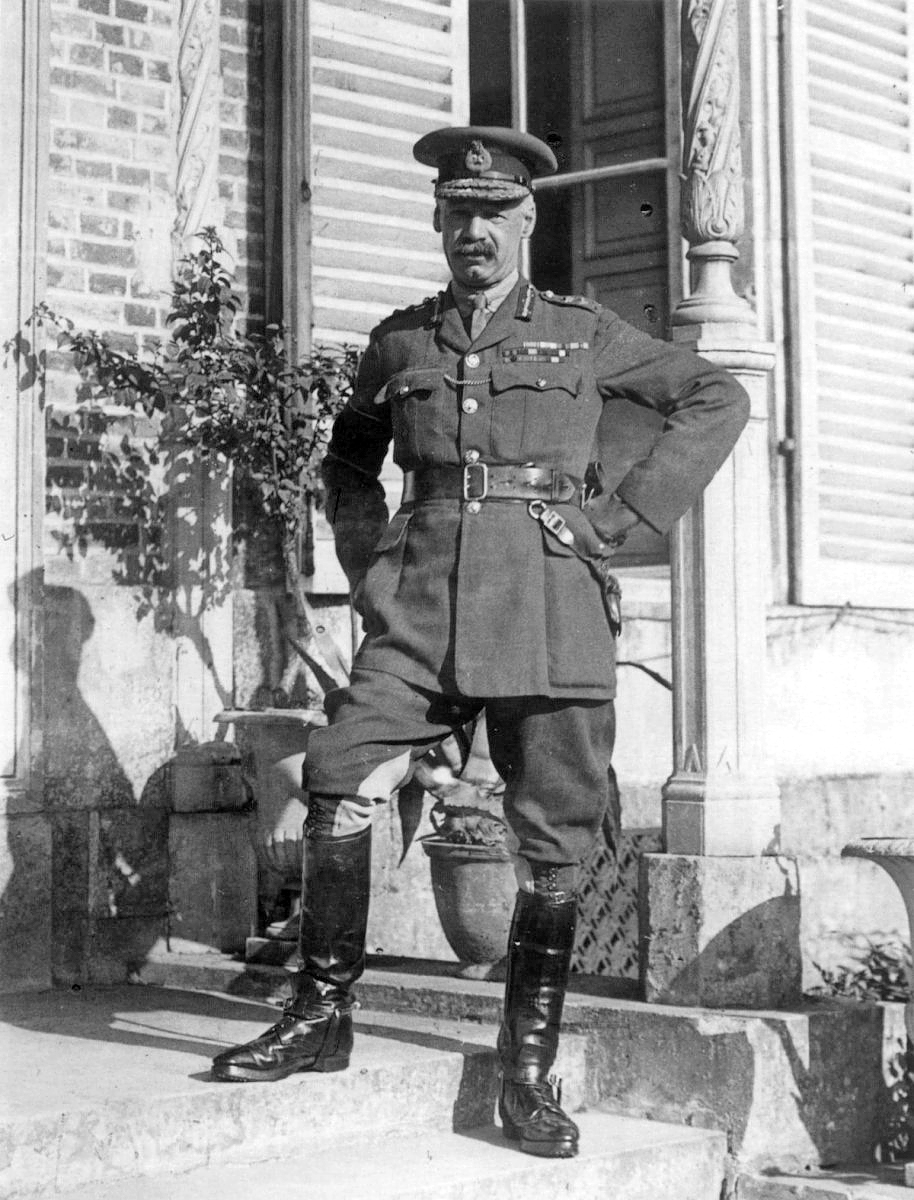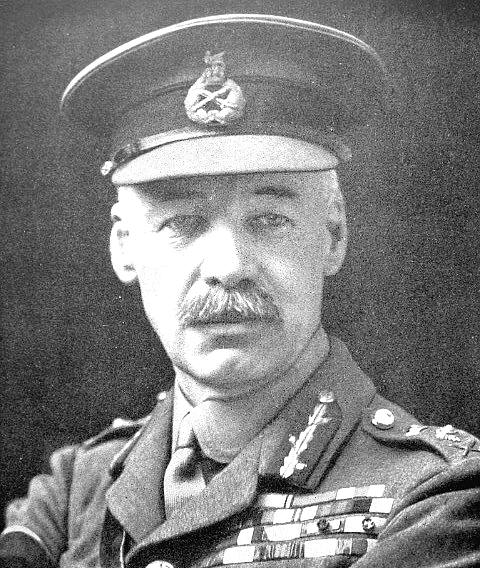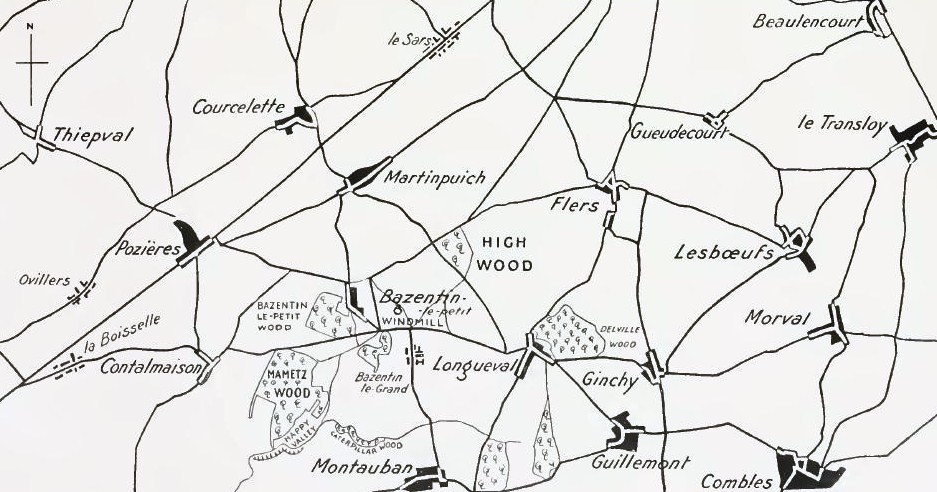|
Battle Of Pozières
The Battle of Pozières (23 July – 3 September 1916) took place in northern France around the village of Pozières, during the Battle of the Somme. The costly fighting ended with the British in possession of the plateau north and east of the village, in a position to menace the German bastion of Thiepval from the rear. The Australian official historian Charles Bean wrote that Pozières ridge "is more densely sown with Australian sacrifice than any other place on earth". Prelude The village of Pozières, on the Albert–Bapaume road, lies atop a ridge approximately in the centre of what was the British sector of the Somme battlefield. Close by the village is the highest point on the battlefield. Pozières was an important German defensive position; the fortified village was an outpost to the second defensive trench system, which had become known to the British as the O.G. (Old German) lines. This German second line extended from beyond Mouquet Farm in the north, ran behind ... [...More Info...] [...Related Items...] OR: [Wikipedia] [Google] [Baidu] |
Battle Of The Somme
The Battle of the Somme (French: Bataille de la Somme), also known as the Somme offensive, was a battle of the First World War fought by the armies of the British Empire and French Third Republic against the German Empire. It took place between 1 July and 18 November 1916 on both sides of the upper reaches of the Somme, a river in France. The battle was intended to hasten a victory for the Allies. More than three million men fought in the battle of whom one million were wounded or killed, making it one of the deadliest battles in human history. The French and British had committed themselves to an offensive on the Somme during the Chantilly Conference in December 1915. The Allies agreed upon a strategy of combined offensives against the Central Powers in 1916 by the French, Russian, British and Italian armies, with the Somme offensive as the Franco-British contribution. Initial plans called for the French army to undertake the main part of the Somme offensive, supported ... [...More Info...] [...Related Items...] OR: [Wikipedia] [Google] [Baidu] |
Albert, France
Albert () is a commune in the Somme department in Hauts-de-France in northern France. It is located about halfway between Amiens and Bapaume. History Albert was founded as a Roman outpost, in about 54 BC. After being known by various forms of the name of the local river, the Ancre, it was renamed to Albert after it passed to Charles d'Albert, duc de Luynes. It was a key location in the Battle of the Somme in World War I, and World War I tourism is important for the town. During World War I, the statue of Mary and the infant Jesus – designed by sculptor Albert Roze and dubbed the ''Golden Virgin'' – on top of the Basilica of Our Lady of Brebières was hit by a shell on 15 January 1915 and slumped to a near-horizontal position, where however it remained until further shelling in 1918 destroyed the tower. In his letters home to his wife, Rupert Edward Inglis, who was a former rugby international and now a Forces Chaplain, described passing through Alb ... [...More Info...] [...Related Items...] OR: [Wikipedia] [Google] [Baidu] |
Delville Wood
The Battle of Delville Wood was a series of engagements in the 1916 Battle of the Somme in the First World War, between the armies of the German Empire and the British Empire. Delville Wood , was a thick tangle of trees, chiefly beech and hornbeam (the wood has been replanted with oak and birch by the South African government), with dense hazel thickets, intersected by grassy rides, to the east of Longueval. As part of a general offensive starting on 14 July, which became known as the Battle of Bazentin Ridge General Douglas Haig, Commander of the British Expeditionary Force, intended to capture the German second position between Delville Wood and Bazentin le Petit. The attack achieved this objective and was a considerable though costly success. British attacks and German counter-attacks on the wood continued for the next seven weeks, until just before the Battle of Flers–Courcelette the third British general attack in the Battle of the Somme. The 1st South Afric ... [...More Info...] [...Related Items...] OR: [Wikipedia] [Google] [Baidu] |
High Wood
The Attacks on High Wood, near Bazentin le Petit in the Somme ''département'' of northern France, took place between the British Fourth Army and the German 1st Army during the Battle of the Somme. After the Battle of Bazentin Ridge on 14 July 1916, High Wood lay undefended for most of the day but delays in communication and confusion caused by orders and counter-orders from British corps headquarters, which had overlapping responsibilities, led to the occupation of High Wood being forestalled by German reserves, which had moved forward to counter-attack British troops in the villages of Bazentin-le-Grand and Bazentin-le-Petit. Men from the 7th Division managed to occupy the southern half of the wood and two cavalry squadrons advanced on the east side to Wood Lane, which connected the wood to Longueval. On 15 July, the wood was evacuated by the survivors and the cavalry retired. The British and the Germans fought for control of the wood from 14 July to 15 September. Both si ... [...More Info...] [...Related Items...] OR: [Wikipedia] [Google] [Baidu] |
Ammunition
Ammunition (informally ammo) is the material fired, scattered, dropped, or detonated from any weapon or weapon system. Ammunition is both expendable weapons (e.g., bombs, missiles, grenades, land mines) and the component parts of other weapons that create the effect on a target (e.g., bullets and Warhead, warheads). The purpose of ammunition is to project a force against a selected Targeting (warfare), target to have an effect (usually, but not always, lethal). An example of ammunition is the firearm Cartridge (firearms), cartridge, which includes all components required to deliver the weapon effect in a single package. Until the 20th century, black powder was the most common propellant used but has now been replaced in nearly all cases by modern compounds. Ammunition comes in a great range of sizes and types and is often designed to work only in specific weapons systems. However, there are internationally recognized standards for certain ammunition types (e.g., 5.56×45mm N ... [...More Info...] [...Related Items...] OR: [Wikipedia] [Google] [Baidu] |
General
A general officer is an officer of high rank in the armies, and in some nations' air forces, space forces, and marines or naval infantry. In some usages the term "general officer" refers to a rank above colonel."general, adj. and n.". OED Online. March 2021. Oxford University Press. https://www.oed.com/view/Entry/77489?rskey=dCKrg4&result=1 (accessed May 11, 2021) The term ''general'' is used in two ways: as the generic title for all grades of general officer and as a specific rank. It originates in the 16th century, as a shortening of '' captain general'', which rank was taken from Middle French ''capitaine général''. The adjective ''general'' had been affixed to officer designations since the late medieval period to indicate relative superiority or an extended jurisdiction. Today, the title of ''general'' is known in some countries as a four-star rank. However, different countries use different systems of stars or other insignia for senior ranks. It has a NATO ... [...More Info...] [...Related Items...] OR: [Wikipedia] [Google] [Baidu] |
Henry Seymour Rawlinson
General Henry Seymour Rawlinson, 1st Baron Rawlinson, (20 February 1864 – 28 March 1925), known as Sir Henry Rawlinson, 2nd Baronet between 1895 and 1919, was a senior British Army officer in the First World War who commanded the Fourth Army of the British Expeditionary Force at the battles of the Somme (1916) and Amiens (1918) as well as the breaking of the Hindenburg Line (1918). He commanded the Indian Army from 1920 to 1925. Early life Rawlinson was born at Trent Manor in Dorset on 20 February 1864. His father, Sir Henry Rawlinson, 1st Baronet, was an Army officer, and a renowned Middle East scholar who is generally recognised as the father of Assyriology. He received his early formal education at Eton College. Early military career After passing through commissioned officer training at the Royal Military College, Sandhurst, Rawlinson entered the British Army as a lieutenant in the King's Royal Rifle Corps in India on 6 February 1884. His father arranged for him to ser ... [...More Info...] [...Related Items...] OR: [Wikipedia] [Google] [Baidu] |
Lieutenant General
Lieutenant general (Lt Gen, LTG and similar) is a three-star military rank (NATO code OF-8) used in many countries. The rank traces its origins to the Middle Ages, where the title of lieutenant general was held by the second-in-command on the battlefield, who was normally subordinate to a captain general. In modern armies, lieutenant general normally ranks immediately below general and above major general; it is equivalent to the navy rank of vice admiral, and in air forces with a separate rank structure, it is equivalent to air marshal. A lieutenant general commands an army corps, made up of typically three army divisions, and consisting of around 60 000 to 70 000 soldiers (U.S.). The seeming incongruity that a lieutenant general outranks a major general (whereas a major outranks a lieutenant) is due to the derivation of major general from sergeant major general, which was a rank subordinate to lieutenant general (as a lieutenant outranks a sergeant major). In contrast ... [...More Info...] [...Related Items...] OR: [Wikipedia] [Google] [Baidu] |
British Fourth Army
The Fourth Army was a field army that formed part of the British Expeditionary Force during the First World War. The Fourth Army was formed on 5 February 1916 under the command of General Sir Henry Rawlinson to carry out the main British contribution to the Battle of the Somme. First World War History The Fourth Army was formed in France on 5 February 1916, under the command of Sir Henry Rawlinson. It was created in preparation for the Battle of the Somme after the French Tenth Army was transferred to the Battle of Verdun. On the first day on the Somme, eleven Fourth Army divisions (from XIII Corps, XV Corps, III Corps, X Corps and VIII Corps) attacked astride the Albert–Bapaume road. The attack was completely defeated on the northern sector, so subsequent Fourth Army operations concentrated on the southern sector, handing control of the northern sector to the Reserve Army. The plan for the Fourth Army during the Third Battle of Ypres (31 July – 10 November 1917), ... [...More Info...] [...Related Items...] OR: [Wikipedia] [Google] [Baidu] |
Battle Of Bazentin Ridge
The Battle of Bazentin Ridge was part of the Battle of the Somme on the Western Front in France, during the First World War. On 14 July, the British Fourth Army (General Henry Rawlinson) made a dawn attack against the German 2nd Army (General Fritz von Below) in the Brown Position (), from Delville Wood westwards to Bazentin le Petit Wood. Dismissed beforehand by a French commander as "an attack organized for amateurs by amateurs", the British succeeded. Attempts to use the opportunity to capture High Wood failed, due to the German success in holding on to the north end of Longueval and parts of Delville Wood, from which attacks on High Wood could be engaged from the flank. The British cavalry, intended to provide a faster-moving exploitation force, was badly delayed by the devastated ground, shell-holes and derelict trenches. In the afternoon, infantry of the British 7th Division attacked High Wood, when an earlier advance could have occupied the wood unopposed. The Br ... [...More Info...] [...Related Items...] OR: [Wikipedia] [Google] [Baidu] |
Longueval
Longueval () is a commune in the Somme department in Hauts-de-France in northern France. Geography Longueval is located northwest of Amiens on the D919 road, at the junction with the D8. Longueval is found in the north-east of the département, almost equidistant to the surrounding towns of Péronne (to the east), Albert (west) and Bapaume (north). Population Heraldry History The village was almost completely destroyed during World War I. World War I sites Caterpillar Valley Cemetery is located outside Longueval, on the road to Bazentin. The cemetery also contains a Memorial to the Missing from New Zealand, recording the names of 1272 men lost in 1916. The body for the New Zealand Tomb of the Unknown Warrior was taken from here. South of Longueval is the Longueval Road Cemetery. In the centre of the village is the Pipers' Memorial, built to commemorate bagpipers who fought in the First World War. Longueval was chosen because it was retaken by the 9th (Scottish) ... [...More Info...] [...Related Items...] OR: [Wikipedia] [Google] [Baidu] |
Bazentin Le Petit
Bazentin () is a commune in the Somme department in Hauts-de-France in northern France. Geography Situated between Amiens to the southwest and Arras to the north, on the D73 road. Population History * 1914–1918: The village, in the middle of the war zone, was completely destroyed. Places and monuments * Memorial to the naturalist Jean-Baptiste Lamarck * Bazentin-le-Petit Military Cemetery * Bazentin-le-Petit Communal Cemetery Extension People * Birthplace of Jean-Baptiste Lamarck, 1 August 1744 Gallery Image:Bazentin_village-natal.jpg, Plaque denoting Lamarck's birthplace Image:Bazentin_cimetiere_1918.jpg, Cemetery entrance Image:Bazentin_panneau-1.jpg, Information board in the village Image:Bazentin_eglise-devant.jpg, The church See also *Communes of the Somme department The following is a list of the 772 communes of the Somme department of France. The communes cooperate in the following intercommunalities (as of 2020): [...More Info...] [...Related Items...] OR: [Wikipedia] [Google] [Baidu] |
.jpg)





